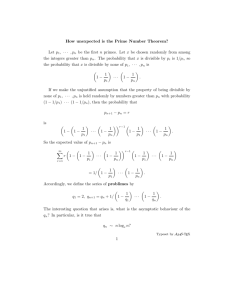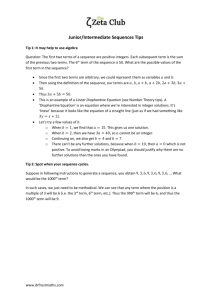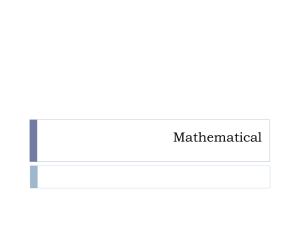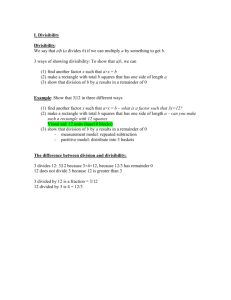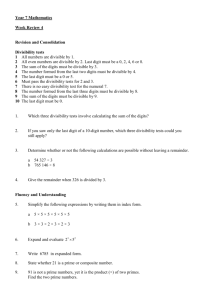The Fundamental Theorem of Arithmetic
advertisement
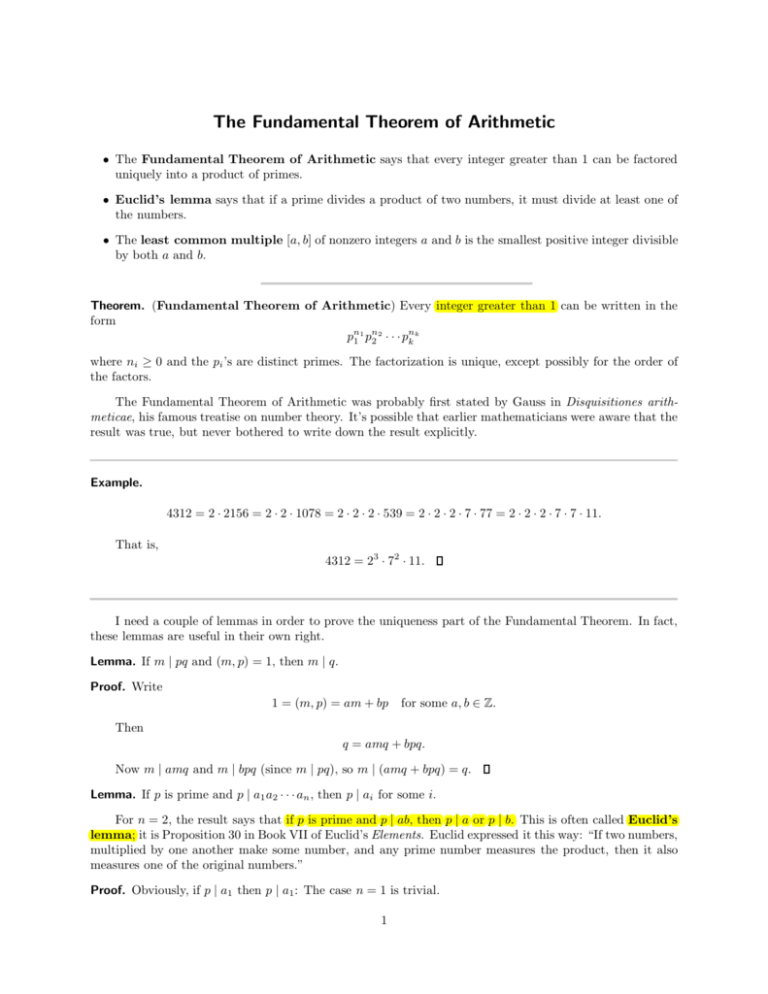
7-23-2006 The Fundamental Theorem of Arithmetic • The Fundamental Theorem of Arithmetic says that every integer greater than 1 can be factored uniquely into a product of primes. • Euclid’s lemma says that if a prime divides a product of two numbers, it must divide at least one of the numbers. • The least common multiple [a, b] of nonzero integers a and b is the smallest positive integer divisible by both a and b. Theorem. (Fundamental Theorem of Arithmetic) Every integer greater than 1 can be written in the form pn1 1 pn2 2 · · · pnk k where ni ≥ 0 and the pi ’s are distinct primes. The factorization is unique, except possibly for the order of the factors. The Fundamental Theorem of Arithmetic was probably first stated by Gauss in Disquisitiones arithmeticae, his famous treatise on number theory. It’s possible that earlier mathematicians were aware that the result was true, but never bothered to write down the result explicitly. Example. 4312 = 2 · 2156 = 2 · 2 · 1078 = 2 · 2 · 2 · 539 = 2 · 2 · 2 · 7 · 77 = 2 · 2 · 2 · 7 · 7 · 11. That is, 4312 = 23 · 72 · 11. I need a couple of lemmas in order to prove the uniqueness part of the Fundamental Theorem. In fact, these lemmas are useful in their own right. Lemma. If m | pq and (m, p) = 1, then m | q. Proof. Write 1 = (m, p) = am + bp for some a, b ∈ Z. Then q = amq + bpq. Now m | amq and m | bpq (since m | pq), so m | (amq + bpq) = q. Lemma. If p is prime and p | a1 a2 · · · an , then p | ai for some i. For n = 2, the result says that if p is prime and p | ab, then p | a or p | b. This is often called Euclid’s lemma; it is Proposition 30 in Book VII of Euclid’s Elements. Euclid expressed it this way: “If two numbers, multiplied by one another make some number, and any prime number measures the product, then it also measures one of the original numbers.” Proof. Obviously, if p | a1 then p | a1 : The case n = 1 is trivial. 1 I need to do the case n = 2 separately because I’ll use it in my induction step. Therefore, suppose p | a1 a2 , and suppose p 6 | a1 . I must show p | a2 . Now p is prime and p 6 | a1 , so (p, a1 ) = 1. (The only factors of p are 1 and p, and p doesn’t divide a1 , so 1 is the only common factor — hence the greatest common factor.) Now p | a2 by the preceding lemma. This establishes the result for n = 2. Assume n > 2, and assume the result is true for products of fewer than n ai ’s. Suppose that p | a1 a2 · · · an . I have to show that p divides on of the a’s. By grouping the terms, I have p | (a1 a2 · · · an−1 )an . By the case n = 2, either p | a1 a2 · · · an−1 or p | an . If p | an , I’m done. Otherwise, if p | a1 a2 · · · an−1 , then p divides one of a1 , a2 , . . . , an−1 , by induction. In either case, I’ve shown that p divides one of the ai ’s, which completes the induction step and the proof. Proof. (Fundamental Theorem of Arithmetic) First, I’ll use induction to show that every integer greater than 1 can be expressed as a product of primes. n = 2 is prime, so the result is true for n = 2. Suppose n > 2, and assume every number less than n can be factored into a product of primes. If n is prime, I’m done. Otherwise, n is composite, so I can factor n as n = ab, where 1 < a, b < n. By induction, a and b can be factored into primes. Then n = ab show that n can, too. Now I’ll prove the uniqueness part of the Fundamental Theorem. Suppose mj 1 pm = q1n1 · · · qknk , 1 · · · pj where the p’s are distinct primes, the q’s are distinct primes, and all the exponents are greater than or equal a to 1. I want to show that j = k, and that each pm is qbnb for some b — that is, pa = qb and ma = nb . a Look at p1 . It divides the left side, so it divides the right side. By the last lemma, p1 | qini for some i. But qini is qi · · · qi (ni times), so again by the last lemma, p1 | qi . Since p1 and qi are prime, p1 = qi . To avoid a mess, renumber the q’s so qi becomes q1 and vice versa. Thus, p1 = q1 , and the equation reads mj 1 pm = pn1 1 · · · qknk . 1 · · · pj If m1 > n1 , cancel pn1 1 from both sides, leaving mj 1 −n1 pm · · · pj 1 = q2n2 · · · qknk . This is impossible, since now p1 divides the left side, but not the right. For the same reason m1 < n1 is impossible. It follows that m1 = n1 . So I can kill the p1 ’s off both sides, leaving mj 2 pm 2 · · · pj = q2n2 · · · qknk . Keep going. At each stage, I pair up a power of a p with a power of a q, and the preceding argument shows the powers are equal. I can’t wind up with any primes left over at the end, or else I’d have a product of primes equal to 1. So everything paired up, and the original factorizations were the same (except possibly for the order of the factors). Example. The least common multiple of nonzero integers a and b is the smallest positive integer divisible by both a and b. The least common multiple of a and b is denoted [a, b]. For example, [6, 4] = 12, [33, 15] = 165. Here’s an interesting fact that is easy to derive from the Fundamental Theorem: [a, b](a, b) = ab. 2 Factor a and b in products of primes, but write out all the powers (e.g. write 23 as 2 · 2 · 2): a = p1 · · · pl q 1 · · · q m , b = q 1 · · · q m r1 · · · rn . Here the q’s are the primes a and b have in common, and the p’s and r don’t overlap. Picture: a p p 1 l b q q m 1 r 1 rn From the picture, (a, b) = q1 · · · qm , 2 ab = p1 · · · pl q12 · · · qm r1 · · · rn . [a, b] = p1 · · · pl q1 · · · qm r1 · · · rn , Thus, [a, b](a, b) = ab. Here’s how this result looks for 36 and 90: 36 2 3 2 90 3 5 (36, 90) = 18, [36, 90] = 180, and 36 · 90 = 32400 = 18 · 180. c 2006 by Bruce Ikenaga 3 7-23-2006 Divisibility Tests and Factoring • There are simple tests for divisibility by small numbers such as 2, 3, 5, 7, and 9. These tests involve performing operations on the decimal representation of the number to be tested for divisibility. • Fermat factorization attempts to factor a number by representing it as the difference of two squares. n • The Fermat numbers are numbers of the form Fn = 22 + 1. First, I’ll discuss quick ways for deciding whether a number is divisible by various small integers. In what follows, I’ll assume that numbers are represented as strings of decimal digits (i.e. in base 10) as usual. 1. An integer is divisible by 2 if and only if its last digit is divisible by 2. 2. An integer is divisible by 5 if and only if its last digit is 0 or 5. The proofs for these two tests are nearly identical; I’ll do the one for divisibility by 2 as an example. Suppose the decimal representation of x is xn xn−1 . . . x2 x1 x0 . That is, x0 is the units digit, x1 is the tens digit, and so on. For 1728, x3 = 1, x2 = 7, x1 = 2, x0 = 8. Then x = xn · 10n + xn−1 · 10n−1 + · · · + x1 · 10 + x0 . Since 2 | 10, it follows that 2 | 10n for n ≥ 1. Thus, 2 | x if and only if 2 | x0 — that is, x is even if and only if the units digit x0 is even. Definition. The digital sum of an integer is the result of applying the function SUM(n) = (the sum of the digits in n) iteratively until the result is less than 10. Example. The digital sum of 1728 is 9: 1 + 7 + 2 + 8 = 18, 1 + 8 = 9. The digital sum of 278349 is 6: 2 + 7 + 8 + 3 + 4 + 9 = 33, 3 + 3 = 6. 3. An integer is divisible by 3 if and only if its digital sum is divisible by 3. 4. An integer is divisible by 9 if and only if its digital sum is divisible by 9. I’ll prove the test for divisibility by 9 as an example. Suppose the decimal representation of x is xn xn−1 . . . x2 x1 x0 . 1 Then x = xn · 10n + xn−1 · 10n−1 + · · · + x1 · 10 + x0 . The sum of the digits of x is s = xn + xn−1 + · · · + x1 + x0 . Observe that x − s = xn · 10n + xn−1 · 10n−1 + · · · + x1 · 10 + x0 − (xn + xn−1 + · · · + x1 + x0 ) = xn (10n − 1) + xn−1 (10n−1 − 1) + · · · + x1 (10 − 1). The right side is divisible by 9, because 10 − 1 = 9, 102 − 1 = 99, 103 − 1 = 999, and so on. That is, x − s = something divisible by 9. Hence, if 9 | x, then 9 | s, and if 9 | s, then 9 | x. I’m not quite done, because s isn’t the digital sum — it’s simply the sum of the digits in x, and if this sum has more than one digit, I have to sum its digits, and so on. But the argument above applied to s shows that 9 | s if and only if 9 divides the sum of the digits of s. And 9 divides the sum of the digits of s if and only if 9 divides the sum of the digits of the sum of the digits of s. And so on, till I reach the digital sum. Thus, 9 | x if and only if 9 divides the digital sum of x. 5. To test divisibility by 7, remove the last (units) digit, double it, and subtract it from the remainder of the number. The original number is divisible by 7 if and only if the result is divisible by 7. Example. 9423242 is divisible by 2 and by 9. Here’s how the divisibility by 7 test looks for this number: 942324 − 2 · 2 = 942320, 94232 − 2 · 0 = 94232, 9423 − 2 · 2 = 9419, 941 − 2 · 9 = 923, 92 − 2 · 3 = 86. 86 is not divisible by 7, so 942324 is not divisible by 7. It is difficult to factor a large, arbitrary integer in a reasonable amount of time. You can use simple divisibility tests like those above to deal with “obvious” cases, but the general problem is the object of current research. Here’s a useful idea which is called Fermat factorization. Proposition. Let n be an odd integer. There is a one-to-one correspondence factorizations expressions of n as the ↔ of n difference of two squares Proof. If n = ab, n is odd so a and b are odd. Then a + b and a − b are even, so Now 2 2 a−b a+b − n= 2 2 2 a+b a−b and are integers. 2 2 expresses n as a difference of two squares. Conversely, suppose n is written as as difference of squares: n = s2 − t2 . Then n = (s − t)(s + t) is a factorization of n. You can check that these two procedures — factors to difference and difference to factors — “undo” one another. Example. Use Fermat factorization to factor 4819. The idea is to try to write 4819 as s2 − t2 . I will form s2 − 4819 and increase s till I get a perfect square. What s’s do √ I need to use? First, 4819 ≈ 69.4. Since 4819 = s2 − t2 , s must be at least as big as 69.4 ≈ 70. On the other hand, the factorization with the biggest factor is 4819 = 1 · 4819. By the proof of the last 4819 + 1 = 2410. So I need to try s for 70 ≤ s ≤ 2410. result, this would produce an s of the form 2 On the very first try, 702 − 4819 = 4900 − 4819 = 81 = 92 . Thus, s = 70 and t = 9. s + t = 79, s − t = 61, and 79 · 61 = 4819. Example. Use Fermat factorization to factor 779. √ 779 ≈ 27.91057, so I need s ≥ 28. 779 + 1 = 390, so s ≤ 390. 2 282 − 779 = 5, 292 − 779 = 62, 302 − 779 = 121 = 112 . The factors are 30 + 11 = 41 and 30 − 11 = 19: 779 = 41 · 19. The Fermat numbers are numbers of the form n Fn = 22 + 1. Fermat thought that all the Fn were prime. However, it turns out that 641 | F5 = 232 + 1. Note that 641 = 24 + 54 and 641 = 27 · 5 + 1. Therefore, 27 · 5 = 641 − 1, and so 228 · 54 = (641 − 1)4 = 641 · junk + 1. On the other hand, 54 = 641 − 24 , so 228 · (641 − 24 ) = 641 · junk + 1, This proves that 641 | 232 + 1. 641 · 228 − 232 = 641 · junk + 1, 232 + 1 = 641 228 − junk . 3 Here are some properties of the Fermat numbers. Proposition. If p is prime and p | Fn , then p = k · 2n+2 + 1 for some k. I won’t prove this result, since the proof requires some stuff about quadratic residues which I won’t discuss for a while. Here’s how it can be used. 4 Example. F4 = 22 + 1 = 65537. Here n = 4, so all prime divisors must have the form k · 26 + 1 = 64k + 1. There are around 1024 numbers less than 65537 of this form, but I only need to check numbers up to the √ square root: 65537 ≈ 256. There are only 4 numbers of the form 64k + 1 less than 256: 1, 65, 129, and 193. 1 is a trivial factor, while 65 and 129 aren’t prime. 193 is prime, but it doesn’t divide 65537. Conclusion: 65537 must be prime! Proposition. F0 F1 · · · Fn−1 = Fn − 2 for n > 0. Proof. I’ll prove the result by induction. F0 = 3 and F1 = 5, so F0 = F1 − 2. The result is true for n = 1. Take n > 0, and assume the result is true for n; I’ll try to prove it for n + 1. By assumption, F0 F1 · · · Fn−1 = Fn − 2, so F0 F1 · · · Fn−1 Fn = (Fn − 2)Fn . Now n n n (Fn − 2)Fn = (22 − 1)(22 + 1) = 22·2 − 1 = 22 n+1 − 1 = 22 n+1 + 1 − 2 = Fn+1 − 2. That is, F0 F1 · · · Fn−1 Fn = Fn+1 − 2. This is the statement for n + 1, so the proof is complete, by induction. Proposition. If m 6= n, (Fm , Fn) = 1. Proof. Assume m < n (if not, switch m and n). Suppose p is prime and p | Fm and p | Fn . I have Fn − 2 = F0 F1 · · · Fn−1 , so Fn − F0 F1 · · · Fn−1 = 2. Note that p | F0 F1 · · · Fn−1 , since p | Fm and m < n implies that Fm is one of the F ’s in this product. Since p | Fn , the equation above shows that p | 2. Since p is prime, this means that p = 2. But this is impossible, since all the Fn ’s are odd. Therefore, there is no prime dividing both Fm and Fn , and hence (Fm , Fn ) = 1. c 2006 by Bruce Ikenaga 4 7-23-2006 Linear Diophantine Equations • A Diophantine equation is an equation which is to be solved over the integers. • A linear Diophantine equation of the form ax + by = c has solutions if and only if (a, b) | c. There is a similar result for linear Diophantine equations in more than 2 variables. A Diophantine problem is one in which the solutions are required to be integers. Abusing terminology, I’ll refer to Diophantine equations, meaning equations which are to be solved over the integers. Diophantine equations have occupied mathematicians for centuries. L. E. Dickson’s three-volume History of the Theory of Numbers [1] and L. J. Mordell’s Diophantine Equations [2] contain extensive lists of equations with their solutions. Example. The equation x2 + y2 = z 2 has many integer solutions — for example x = 3, y = 4, and z = 5. A solution to this equation is called a Pythagorean triple, since (in case x, y and z are positive) the numbers represent the sides of a right triangle. x3 + y3 = z 3 has many solutions over the reals; for example, √ 3 x = 1, , y = 1, z = 2. However, this equation has no nonzero integer solutions. This is a special case of Fermat’s Last Theorem. It says that the equation xn + yn = z n has no nonzero integer solutions if n ≥ 3. After remaining unproven for over 300 years, it was finally settled in 1993 by Andrew Wiles. Example. Since (9, 100) = 1, the Extended Euclidean Algorithm can be used to find integers x and y such that 9x + 100y = 1. For example, 9 · (−11) + 100 · 1 = 1, and 9 · 89 + 100 · (−8) = 1. That is, the Diophantine equation 9x + 100y = 1 has solutions — in fact, infinitely many solutions. Linear equations are the simplest kind of equations. This result tells when a 2-variables linear Diophantine equation is solvable. Theorem. Let a, b, c ∈ Z. Consider the Diophantine equation ax + by = c. (a) If (a, b) 6 | c, there are no solutions. (b) If (a, b) = d | c, there are infinitely many solutions of the form x= b k + x0 , d Here (x0 , y0 ) is a particular solution, and k ∈ Z. 1 a y = − k + y0 . d Proof. Consider the linear Diophantine equation ax + by = c. Case 1. Suppose (a, b) 6 | c. If x and y solve the equation, then (a, b) | ax + by = c. տ ր Hence, there cannot be a solution. Case 2. Suppose (a, b) | c. Write c = k(a, b) for k ∈ Z. There are integers m and n such that am + bn = (a, b). Then amk + bnk = (a, b)k = c. Hence, x = km, y = kn, is a solution. Suppose x = x0 , y = y0 , is a particular solution. Then ab a b ab a k + x0 + b − k + y0 = k − k + (ax0 + by0 ) = 0 + c = c. d d d d a b k + x0 , y = − k + y0 is a solution for every k ∈ Z. d d Finally, I want to show that every solution has this form. Suppose then that (x, y) is a solution. Then ax + by = c and ax0 + by0 = c imply This proves that x = a(x − x0 ) + b(y − y0 ) = c − c = 0. Therefore, b a (x − x0 ) + (y − y0 ) = 0, (a, b) (a, b) b a (x − x0 ) = − (y − y0 ). (a, b) (a, b) a Now divides the left side, so it divides the right side. However, (a, b) Thus, a y − y0 , (a, b) or y − y0 = k · y = y0 + k · a b , (a, b) (a, b) a for some k. (a, b) a . (a, b) Substitute this back into the last x-y equation: b b a a (x − x0 ) = − (y − y0 ) = − k· , (a, b) (a, b) (a, b) (a, b) x − x0 = −k · x = x0 − k · b , (a, b) b . (a, b) This is the result stated in the theorem (with an unimportant switch of k and −k.) 2 = 1. Therefore, Example. Solve 6x + 9y = 5. Since (6, 9) = 3 6 | 5, the equation has no solutions. Example. Solve 6x + 9y = 21. Since (6, 9) = 3 | 21, there are infinitely many solutions. By trial and error, x0 = −7, y0 = 7, is a particular solution. Hence, the general solution is x = 3k − 7, y = −2k + 7. For example, setting k = 5 produces the solution x = 8, y = −3. Example. Solve 71x + 45y = 32. Since (71, 45) = 1 | 32, there are infinitely many solutions. But how can I find a particular solution? Use the Extended Euclidean Algorithm to write 1 = (71, 45) as a linear combination of 71 and 45: I have a q y 71 - 30 45 1 19 26 1 11 19 1 8 7 2 3 5 1 2 2 2 1 1 2 0 71 · (−19) + 45 · 30 = 1 32(71 · (−19) + 45 · 30) = 32 · 1 71 · [32 · (−19)] + 45 · (32 · 30) = 32 71 · (−608) + 45 · 960 = 32 (Notice how I multiplied the 32 into the numbers −19 and 30, not the coefficients 71 and 45 of the original equation.) If you compare the last equation to 71x + 45 = 32, you can see that x0 = −608 and y0 = 960 comprise a particular solution. Therefore, the general solution is x = 45k − 608, y = −71k + 960. I won’t give a proof of the result for more than 2 variables, but I’ll illustrate how to reduce the 3-variable case to the 2-variable case by example. 3 Example. Solve the Diophantine equation 3x + 3y + 5z = 10. First, I’ll factor (3, 3) out of the first two coefficients: (3, 3) 3 3 x+ y + 5z = 10. (3, 3) (3, 3) Notice that (3, 3) = 3, so those two fractions are actually integers. I’m not simplifying you can see what’s going on. Let w= 3 so that (3, 3) 3 3 x+ y. (3, 3) (3, 3) The equation becomes (3, 3)w + 5z = 10, or 3w + 5z = 10. (3, 5) = 1 | 10, so this two variable equation is solvable. x = 5, y = −1, is a particular solution, so the general solution is w = 5s + 5, z = −3s − 1. Now I have to find x and y: w= 3 3 x+ y, (3, 3) (3, 3) so w = x + y. Thus, x + y = 5s + 5. This is a two variable equation. Since (1, 1) = 1 | 5s + 5, it’s solvable. x = 5, y = 5s, is a particular solution. Therefore, the general solution is x = t + 5, y = 5s − t. All together, the general solution to the original three variable equation is x = t + 5, y = 5s − t, z = −3s − 1. In general, if there is a solution to the linear Diophantine equation a1 x1 + · · · an xn = c, the solution will depend on n − 1 parameters — exactly as you’d expect from linear algebra. [1] Leonard Eugene Dickson, History of the Theory of Numbers (volumes I, II, and III). Bronx, NY: Chelsea Publishing, 1992. [2] L. J. Mordell, Diophantine Equations. New York: Academic Press, 1969. c 2006 by Bruce Ikenaga 4
